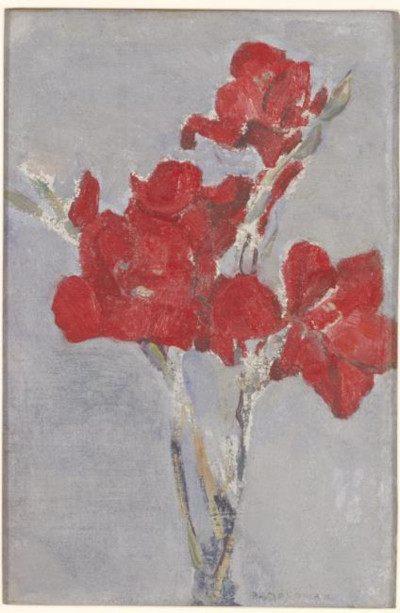Gladioli in a Bottle was painted by Dutch artist Piet Mondrian in around 1906. Some have argued that the original name of the piece was actually just, Gladioli, and this issue was raised within a catalogue raisonne of the artist's career which was released in 1998.
The artist delivers several red flower heads within this piece and they dominate the centre of this artwork. They have been angled in different directions in order to make the composition appear as natural as possible and are likely to have been placed within a bottle with a narrow neck in order to keep the stems as close together as possible. Mondrian uses tones of colour for the stems which are not particularly different to the grey used for the background, and this allows the flower heads to really achieve a strong focus within the work, just as he would have intended. The layout is carefully done, with the tip of the highest flower just falling short of the top of the painting and horizontally, we find most of the flowers captured within. He does not allow too much space for the stems as this would unbalance the piece and leave large areas relatively plain and uninteresting. He does, however, allow touches of white paint to decorate some sides of the stems, particularly higher up the work, and this gives a small suggestion of light interacting with the Gladioli.
The catalogue raisonne of 1998 gives a looser date for this painting of 1905-1907, but most conclude that the likest timing was in the middle year of that period. Gladioli in a Bottle is 39cm tall and around 20cm wide, making it a relatively small item. It was completed using oil on canvas, just as was the case with most of Mondrian's work, although he was also a highly skilled draughtsman. The painting changed through the hands of several different art collectors with the Netherlands before eventually making its way across to the US. Eventually it would put on loan to the Minneapolis Institute of Arts, before being bequethed to the same institution in 1991. This is the route taken by many artworks, from private collections to eventually being available for the public to see in galleries and museums such as this. Several Mondrian paintings took a similar journey, whilst others remain in the Netherlands.
Across his lifetime Mondrian would complete a good number of flower paintings and liked the technical challenges brought about by still life art more generally. Some other examples of his work in this genre included the likes of Still Life with Apples, a Pot with Flowers and a Metal Pan, White Phloxes and Chrysanthemum (1906). He would vary the species in order to achieve different looks and colour would also be a major consideration for him when selecting between different flowers. Some artists would actually go as far as to grow their own choices themselves, but Mondrian would not devote himself enough to this topic to really make that worthwhile. He was highly knowledgeable on artists from the past and so would take on more traditional topics such as this from time to time, though normally would attempt to incorporate a more contemporary style when doing so.




